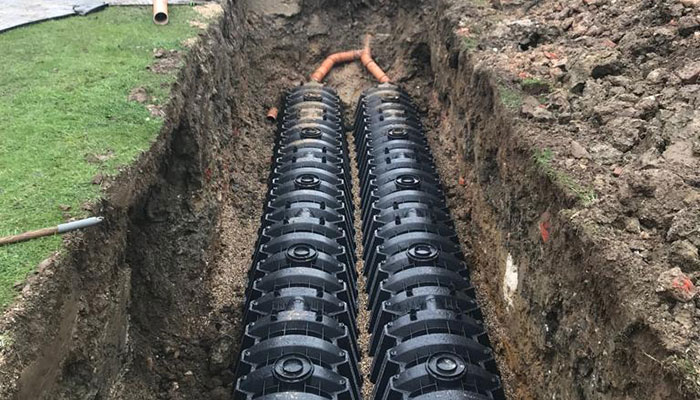Unless you’ve been living in a dungeon, you cannot fail to have seen how much rain there has been in England over the past couple of months. Whilst it has given us plenty of opportunities to hibernate with a good book, such a hefty downpour has caused all manner of problems for homeowners from leaking roofs to full on flooding. But what about the houses which aren’t connected to a mains sewerage system? Have they seen any specific issues? If you’re the proud owner of a septic tank or sewage treatment plant, you should also have a drainage field or ‘soakaway’ near it. And they could have been impacted by the weather – but what else? Read on to find out what to do if your soakaway fails.
What Is A Soakaway?
A soakaway (as you may know) is the route for your wastewater to pass into the ground which will then filter it to neutralise any pollutant effects of the waste which is flushed down your drains.
It’s basically a network of pipes coming off your sewage treatment plant that is perforated in order to allow the waste water to literally soak away into the ground. The surrounding soil has to be of a certain calibre in order to ensure it can get rid of the nastiness in it which would otherwise damage the local environment and pollute watercourses. When it operates as it should, a soakaway is an impressive structure that hopefully you don’t have to think about too often. However, when it fails, a whole world of difficulty is presented.
So, have you surveyed the area around your drainage field? Is it waterlogged because of the amount of rain or could it be a more pernicious reason such as a problem underground? If there are any foul smells wafting upwards then it might be time to take a closer look.
How Might My Soakaway Fail and How Can I Fix It?
If you have an issue with your system, the chances are you need to know what to do if your soakaway fails. Below are some of the most common problems and the solutions to deal with them.
Problem: waterlogged ground might be the first reason your soakaway will fail. If the surrounding area is already at absolute capacity, it won’t be able to absorb anymore which could cause issues within your sewage system. If the water can’t soakaway, it will back up into the system and if it persists, will then back up your drains and will even end up coming back up your toilets and pipework.
Solution: if heavy rain is forecast, make sure your septic tank is in good order beforehand by getting it emptied. Also ensure that other drains around your property are cleared including anything that might cause water to run off straight to the drainage field. So clear any leaves from gutters or drains, unblock any issues and so on. Avoid putting anything heavy such as machinery or vehicles on the drainage field too as these will compact the soil and hinder its absorption ability even more. During the rainy period, try to minimise the water going down your drains too (take shorter showers and wait to wash certain clothes, for example).
Problem: a blockage somewhere. This can cause water to back up into the system or can damage the soakaway itself.
Solution: a blockage can be the result of a full chamber as this can cause waste to overflow and seep out where it should not go. If that is the case, have it emptied and then ensure it is emptied regularly. Ask whoever does your emptying how frequently they think it should be done and stick to it to avoid similar situations in the future. If the blockage is caused by some rogue materials being flushed down the drains, this will need addressing too. Fats and oils can be some of the worst culprits as they coat the drainage pipes and seal them shut preventing the water from escaping. Remind your household residents what can and can’t be flushed down the drains but if a significant problem has occurred then you may need a professional inspection and service to clear any problem.
Problem: damage to parts of your sewage system that consequently affect the soakaway such as issues with the baffle. The baffle is what prevents the solid waste from passing out of the chamber and into the soakaway pipes. If it fails, the chunky stuff will escape and will block the holes through which the waste water is supposed to pass into the ground.
Solution: get your baffle fixed! Soakaways are not designed to take any solids at all so the chances are your system might be damaged and if so, it may need replacing in full. The only way to be sure would be to employ the services of an expert and have them survey it properly.
Problem: tree root damage. The roots of trees can spread far and wide so even if a tree doesn’t seem particularly close to your system, there may still be some damage that you can’t see.
Solution: unfortunately, it is unlikely a fix would be easy for this and given tree roots’ propensity to keep growing, short of killing the tree, further problems might arise in your system at a later date. It would be advisable to move it to a new site.
If your soakaway has significant issues or has failed entirely, there might be no option but to have it replaced. Regardless of the problem, it may be worth your while to call on the services of a local professional to ascertain what is wrong and fix it, if possible.
And don’t forget to keep your sewage system maintained on a regular basis as this could prevent anything from arising in the first place. It’s now time to stop wondering what to do if your soakaway fails and get in touch with us today.
